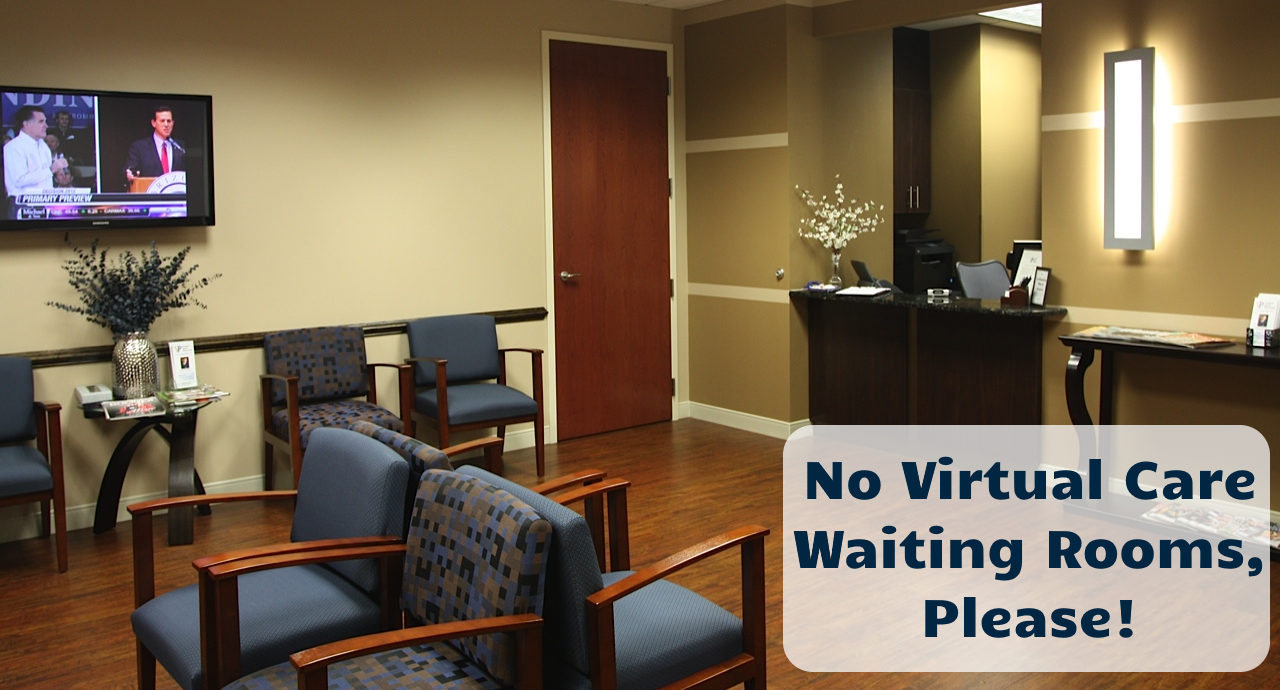As we are getting more and more familiar with the new virtual care paradigm, the “new normal” seems to slowly now also embrace the widespread abomination of traditional care: Making Patients Wait.
Thus my plea is: No Virtual Care Waiting Rooms, please!
Virtual Care Waiting Rooms are Necessary!
Now, don’t get me wrong — having a virtual waiting room is a critical feature for a great experience for both clinicians and patients. Just a few weeks ago I helped one of my clients, a behavioral health clinic, turn on their video solutions’ waiting room feature. This greatly enhanced their workflow and provided much stress relief for the clinician.
Waiting Rooms in Virtual Care are a critical feature, as they allow clinicians to start the meeting when they are prepared and ready. It puts the clinician in control – similar to opening the door to the exam room or walking down the hallway to pick up the patient from the waiting room.
One principle I keep coming back to when designing virtual care workflows is to mirror as much as possible the in-person experience. But that does not mean that we should strive to make patients wait for 15, 20 minutes in a “waiting room”. Please don’t!
What is so exciting about creating virtual care workflows, is we have a chance to eliminate the deficiencies and problems of our current in person care workflow. And making patients jump through so many hoops and making them wait gotta be on the top of that list.
Video in Waiting Rooms
A few weeks ago, a thought-provoking question reached me from one of the over 500 subscribers of my Telehealth Tuesday Newsletter:
“Do some telehealth systems feature “waiting rooms” where patient videos are played as the patient awaits their appointment? If so, how’s it going for them? Are clinics using that feature?
I’ve been hearing about the idea of playing videos (mostly, educational videos) in virtual waiting rooms as long as 10 years ago when one now defunct vendor developed a slick workflow solution on top of a then-common video platform. Their solution allowed the seamless handoffs from a nurse to a primary care physician to a specialist back to the nurse. During the inevitable wait time, the patient was presented with educational images about their care, or promotional information about the services of the clinic or health system.
I know that even recently, there has been a lot of talk about videos in waiting rooms, but to my knowledge that has not been implemented yet in any of the popular virtual care video platforms. One angle that I had heard about is to use the waiting room for promotional videos or even advertisement (to offset the cost of the video platform). I seriously hope that this is not implemented, as then the incentive would be to keep patients at least 5 minutes or more in the waiting room so they will see at least one or two of the advertisements.
The first question though I had when this question was posed to me is: Why? Why would we want to make patient’s wait in the first place? Isn’t making your customers wait one of the worst customer experiences one can have?
So why then, should patients have to wait in the virtual waiting room? Forcing a customer to wait for service is quite an antiquated attitude that we, as patients, have come to accept.
In addition, from my experience, especially over the past months, it seems that in a virtual-only environment, most physicians are no longer running behind – granted, emergency and last-minute shoe-horned-in visits can still derail a physician’s schedule, but that’s actually much harder to do if the physician is conducting his visits from home.
I therefore see very little value of equipping a waiting room with videos, because our goal should be to design the process such that we, as health care consumers, don’t have to wait.
No Wasted Wait Time



One of the many beauties of virtual care is that there no longer has to be the dreaded, unproductive wait time. A relic of thinking that centered first on physician efficiency (yet also a side effect of the unpredictable nature of healthcare), the endless hours spent in waiting rooms leaving through old National Geographic editions or Readers’ Digests are countless.
A quick search for “jokes about waiting rooms” will yield classics like “Actually, there’s nothing wrong with me, but by the time I see the doctor there probably will be.” and “No, I’m not here to see the doctor — just the magazines.” It’s, regrettably, embedded in our culture.
In a virtual care environment, however, with patients typically available at a moment’s notice, we can let patients’ know within minutes when the physician is available to see them.
One elegant virtual care workflow has the nurse call the patient, by phone, when the physician is “5 minutes out”, to capture the chief complaint and the vitals before handing the patient off to the physician. That way I, as the patient, can continue to reply to my emails or watch my favorite TV show, or finish reading Facebook, or put away the folded laundry.
The difference here is that this workflow becomes patient-centric and not everything is optimized solely around physician efficiency.
In summary let me reemphasize, that waiting rooms are an essential feature in virtual care to provide the clinician with the necessary control as to when to start the visit. But ideally patients should be spending no more than one minute in the waiting room. If they do, then it’s time to re-examine your telerooming process.
What do you think? Should we entertain patients in virtual waiting rooms via videos?
You can also download and print a Physicians’ Bill of Telehealth Rights.








To receive articles like these in your Inbox every week, you can subscribe to Christian’s Telehealth Tuesday Newsletter.
Christian Milaster and his team optimize Telehealth Services for health systems and physician practices. Christian is the Founder and President of Ingenium Digital Health Advisors where he and his expert consortium partner with healthcare leaders to enable the delivery of extraordinary care.
Contact Christian by phone or text at 657-464-3648, via email, or video chat.







Leave A Comment